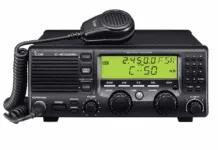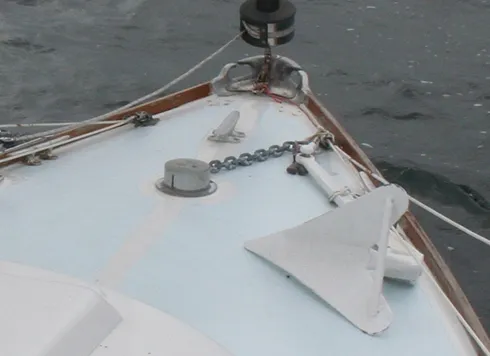I was always amazed at how much water could seep through the chain-pipe and into Toscas anchor locker when a sea was up or we were punching into a head sea-although punching would hardly describe the ungainly motion of a gaff-rigged ketch to weather. Wallowing? Submarining? Regardless, a waterfall greeted whoever dared venture into the v-berth to check on the strange gushing noises. Still, I was happy to have a three-inch diameter hole rather than one of the ice-cream scoops that some contemporary boats have on their bows (see Practical Sailor March 2011).
Anchor lockers are a convenience to coastal cruisers but no friend to offshore sailors. Passagemakers often forgo a deck-clearing locker for a belowdecks anchor-chain well. An angled spill pipe leads the anchor chain from the deck to the well, which often is under the forepeak and behind a watertight bulkhead. The setup not only eliminates the flooded-bow worries inherent with an on-deck locker, but it also moves the chain and anchors weight lower and further aft, where it should be to avoid hobby-horsing.
To keep water out of the belowdecks chain box, you first must keep water from pouring down the spill pipe. We have heard of numerous methods to seal a deck hole-from Silly Putty and duct tape to threaded brass caps and rags-and most of them work in most conditions. The hole-stopper methods PS contributors have found to be effective in even the heaviest of weather (when a boarding sea can create a fire-hose effect) include:
Teak plug: Sized to fit the deck hole and about 6 inches long, with an eye for attaching the chain to the bottom (after its removed from the anchor) and a fitting on top for pulling it out later. Remember that wood will swell when it gets wet, so you may have to pull it out with a halyard. As the wood gets wet, it swells to seal the hole. PS contributors and circumnavigators Evans Starzinger and Beth Leonard use a Delrin plug in the same way, but they bed it with silicone before getting underway.
Closed-cell foam (from a cushion, Nerf ball, or the Forespar TruPlug): PS Technical Editor and bluewater sailor Ralph Naranjo suggests squeezing closed-cell foam like a rubber rivet into the aperture.
Other tried-and-proven methods include leaving the anchor on and spraying canned expanding foam insulation into the hole (this dislodges easily when the anchor is dropped); shoving a tennis ball into the chain-pipe (for a chain still attached to a bow anchor, split the ball half-way and pass the chain through it); cramming a rag into the hole and spraying foam insulation over it.
I’d love to hear how others have solved this age old problem.




































I worked on offshore oceanographic ships and we would stuff rags into the spurling pipe around the chain and mix up a bag of readymix concrete to pour around the chain.
When I went to sea in the late 60s it was standard practice to I seal the spurring pipes with “puddings” then cement and steel plates before wrapping in canvas.
I haven’t tried this yet but plan to. My chain locker and chain pipe are easy to reach from inside the forward berth so these have been on my agenda to dry fit.
https://www.amazon.com/End-Pipe-Gripper-Plug-Inch/dp/B000VYNUAC/ref=asc_df_B000VYNUAC/?tag=hyprod-20&linkCode=df0&hvadid=198093463090&hvpos=&hvnetw=g&hvrand=2484727959451930525&hvpone=&hvptwo=&hvqmt=&hvdev=m&hvdvcmdl=&hvlocint=&hvlocphy=9012691&hvtargid=pla-379548972684&psc=1
Not sure these will fit but if they do should be the cure.
https://www.oatey.com/products/cherne-singlesize-plumbing-testball–1719859634
These if I can find them large enough.
https://store.mocap.com/mocap_en/msp.html?Item=MSP1.881/2.198&QTY=1&mpn=MSP1.881/2.198&pid=MSP1.881/2.198-P&source=googleps&campaignid=1061430216&adgroupid=50204659817&feeditemid=&targetid=pla-414317634919&keyword=&matchtype=&gclid=CjwKCAjwjdOIBhA_EiwAHz8xm76sTHAHs2ttkgjQzAyTFie6Gwc0XC3R9VcIv7ptpPL_-oPQ7MYb0xoCK7MQAvD_BwE
Expanding foam falling off your anchor chain every time you drop it is probably the least environmentally sensitive suggestion I’ve heard of. Practical sailors should by now be aiming to be a little more sensitive to the marine environment that they enjoy!
I use a pool noodle (carved to match the chain links) to plug my chain-pipe.
Our locker on a 38′ Morgan/Catalina has a drain hose so that helps, I cut up a foam noodle and
sliced it so it fits over the shank of the anchor. It helps with water and also birds nesting in the locker.
Our chain drops into a 1-1/2″ pipe, so I use a rubber pipe cap (used by plumbers to cap open pipes for pressure checking) which has two holes punched and a split so it will go over one link of the chain, secured by a hose clamp. I think it would be possible to drop the anchor with this rig in place, although we have never tried. Wish I could post a pic, worth 1,000 words…
I have built 2 cruising multihulls, on both of which I used the 90 deg hawse pipe with the slotted closing flap. I use a line/chain combo to a samson post with the pipe offset from the line between the anchor roller and the post. The first boat had it fixed facing forward, which was a problem if the strain was to the post. The second time, I machined 2 pieces of Ertalyte so that it could rotate. Wish I could post a pic. It works like a charm. I can pay out line directly to the roller or around the post. When at sea, I face it aft with the last link and shackle keeping the lid closed. What little water that gets in is easily handled by the locker drain. Even when anchored, I face it aft in case of driving rain. Have cruised from California to New Zealand over the last 8 yrs with no problem.
I’m thinking that a product like Spartite would make a perfect removable plug. Easy to form, cast in place, removable, extremely durable, doesn’t degrade. I’m thinking and would like to try it unless someone beats me to it.
My answer is I unshackle the anchor and drop the chain after a light chord tie is attached which is kept above deck. Secure the anchor, very securely. Then put a heavy plastic bag or two over the hawser and secure with a cable tie.
“Monkey Dung” (not the trade name, but that’s what everybody calls it ) available at any electrical supply house. designed to seal weather tite meter boxes and other outside electrical entrance wires. It remains pliable for years, can be used over and over ,and sticks well to wood and steel. Looks and handles like children’s modeling plastacine clay. easily forms around the chain to make a water tite seal. very inexpensive. I’ve used the same piece/ blob for years.
I use potters clay, it’s water proof and “sun” proof, and you’ll have a couple pieces to have for future applications.
On my steelboat the construction is as follows: a low-walled ss tub is welded to the deck; 4 ss standbolts are welded into the tub to receive the windlass; the chainpipe lands in the tub also, behind the windlass; a canvas cover protects the whole arrangement, the windlass against corrosion and the chainpipe against water ingress. The chain leaves the cover through a sort of sleeve which is tied tightly around the chain and allows no noticeable amount of water in.